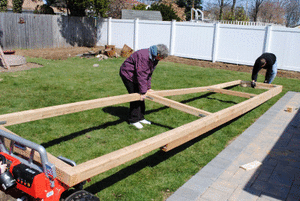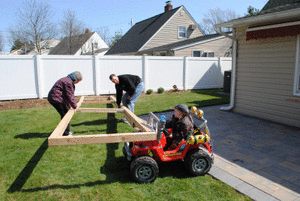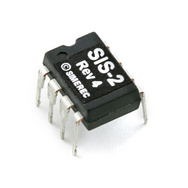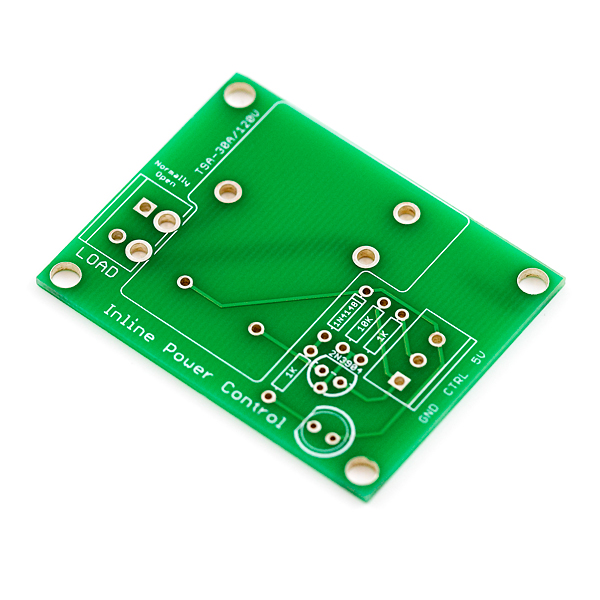Last fall, after holding off for a long time, my wife and I agreed we should get a TV for our bedroom. Neither of us were too keen on the aesthetics of a TV and cable box sitting on the dresser or mounted to the wall, so I started thinking of ways to hide the TV. To be safe we bought a 26" LCD (Vizio VL260M) that could, if necessary, be mounted to the wall just above the mirror.
Here's our bedroom with the TV sitting on the dresser.

My idea was to mount the TV to the wall behind the mirror, and mechanically raise the TV up above the mirror when we wanted to watch it. The gap between the top of the mirror was ~17" and the TV was 16.8" high, perfect!
At first I looked into ready built powered TV lifts. Only one seemed viable, made by
Firgelli Automation.

However, at $600+ it was twice the cost of the TV and not feasible.
My next idea was a pure mechanical lift. My sister-in-law's husband and I spent the better part of Thanksgiving day brainstorming ways to accomplish this (which didn't go over well with my wife and sister-in-law). We considered pulleys, springs, gas pistons, and I finally settled on a parallel arm system, similar to those used for
large binoculars mounts or steady cams.

This would allow the TV to freely move up and down without rotating or hitting the wall, and when balanced would require minimal effort to raise and lower. However, after some calculations of the available space behind the mirror, and the weight of the TV being about 20 lb, I would need to have 40-50 lb of counterweight which was unreasonable.
So I went back to the idea of a powered lift. After all, how cool would it be to just lay in bed and hit a button on the remote to raise the TV.
Firgelli Automation also produces lift actuators, and sells a nice
liner track actuator kit, complete with controller (though unfortunately it's wired).

The
FA-200-TR-24-20" looked to work best as it had a 20" stroke, a 200 lb force, and moved at 1"/sec fully loaded.
My plan was to mount the TV to wall to on sliders that allowed it to move up and down. The actuator would be mounted the wall below the TV and I'd connect the TV to the shuttle by an arm. Then as shuttle moved up, this would raise the TV over the mirror, and when the shuttle moved down, the TV would drop too.
To mount the TV to the wall I bought two
heavy duty drawer slides from Lowes. I chose ones with 22" of travel so that the actuator would determine the actual range of motion, and the TV wouldn't max out at the top or bottom. These were mounted flat on the wall directly into studs using lag bolts. Fortunately the studs were in a location that allowed the TV to be almost dead center between the two slides.

Next came the task of mounting the TV to the slides. I attached an 18"x6" piece of sheet steel between the two slide. The TV has a VESA 100mm mounting pattern, so I mounted the TV to the sheet steel using a
low profile TV wall bracket from Monoprice.


With the two halves of the TV mount connected, the back of the the TV is only 1" from the wall, and the front of the TV about 4.5" from the wall.

To connect the TV to the actuator shuttle, I used a 4' piece of 4x1 poplar hardwood and match drilled the TV stand mounting holes to the wood.


Next up was the track actuator. The actuator itself is about 28" long. I runs of 24VDC and comes with a power supply and wired controller (coiled cable that can stretch about 10 feet) . It's a lot quieter than I expected and is very well made. I was able to mount the actuator below the TV, to the right side stud. It was tight, as the wall outlet was there, but fit. To attach the wood arm to the shuttle, I used a 4"x4" L-bracket.

Finally with everything mounted.

A video of the lift in action.
A closeup of the track actuator.
The end result.
Fully extended the top of the TV is about 1/2" from the ceiling, and fully retracted the top of the TV is about 3" below the top of the mirror. I was able to move the dresser/mirror back such that it is just under 5" from the wall, and nobody walking into the room has noticed it.
Unfortunately
Firgelli Automation only sells an RF wireless controller. But that wasn't going to stop me. Next project, a DIY IR wireless receiver/relay controller...































